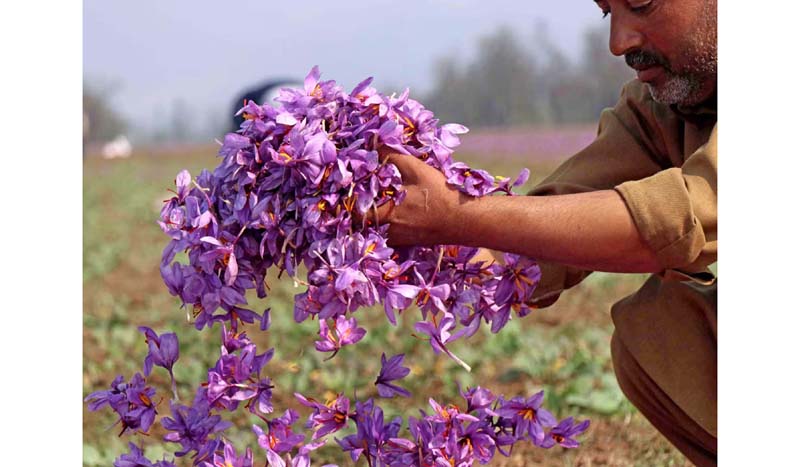Pragati Pachisia
The history of saffron cultivation in Jammu & Kashmir dates back several centuries. The region of Jammu and Kashmir in India has been renowned for its saffron production, particularly in Kashmir. The name Saffron has its origins in the Arabic word Zafaran which means yellow. The favourable climatic conditions and suitable soil composition in the region have made it ideal for saffron cultivation. Globally, the saffron market was valued at 372.9 million American Dollar and is expected to grow at a 757 American Dollar in 2030.
In 2011, the Indian government started the National Mission on Saffron in Jammu and Kashmir after seeing a major decline in its production from 1996-97 to 2010-11. The land for saffron cultivation was reduced from 5707 hectares to 3787 hectares respectively, which reduced the production to 1.88 kg per hectare. The main aim of this Mission was to boost the saffron production and reduce the sufferings of the saffron cultivators. It is estimated that saffron production of 25-27 tonnes will be achieved in coming years. The production has been on an upward trajectory from 1.8 kg per hectare to nearly 5 kg per hectare, due to the implementation of the National Saffron Mission. The rejuvenated areas have achieved an even higher production of approximately 6 kg per hectare compared to the non-rejuvenated regions.
During the 1990s, saffron production in Kashmir reached its peak, averaging around 15.5 metric tonnes annually. However, various factors such as untimely rains, droughts, urban development, and the conversion of saffron fields into commercial ventures led to a decline in production. In 2015, the yield was 11.72 tonnes, which significantly dropped from 1.4 tonnes recorded 4 years earlier. The Indian Government has announced that the saffron yield in Kashmir exceeded 13 metric tonnes in 2020, marking the first time in a decade that such levels were reached. The production has been steadily increasing year by year due to favourable temperatures and Government initiatives.
A significant initiative, known as the “Economic Revival of J&K Saffron Sector,” has been undertaken by policymakers at the State and Central levels. This mega project, operating under the Rashtriya Krishi Vikas Yojana (RKVY) Schemes for Integrated Development of Saffron, has ambitious goals for the rejuvenation of the entire saffron area, spanning 3,715 hectares. The project focuses on key aspects such as the establishment of irrigation facilities through the creation of bore wells and sprinkler distribution systems, the provision of quality saffron dryers, the construction of vermicompost units, soil health improvement, capacity building, and the enhancement of research and extension capabilities.
The saffron fields, locally known as “Saffron Pampore,” are concentrated in the Pampore area. Pulwama of the Kashmir Valley. Pampore has been the traditional hub of saffron cultivation in the region. The project seeks to explore non-traditional areas for saffron production and develop suitable technologies to expand its cultivation and enhance overall productivity. Interestingly, saffron cultivation in Jammu and Kashmir became an integral part of the region’s agriculture and economy. Saffron cultivation requires labour-intensive practices, as the delicate flowers need to be handpicked early in the morning before they wilt. However, factors such as political unrest, weather fluctuations, and changes in agricultural practices have affected saffron production in the region.
Additionally, competition from other saffron-producing regions globally has impacted the market dynamics. Through 2019 to 2022 the government has attempted to rejuvenate certain areas and has been successful in rejuvenating 2598.75 hectares of land which has resulted in more than 15 metric tonnes of produce from these areas, on an average. As of 2021-22 the production per hectare is 4.04 kgs. Furthermore, the Sher-e-Kashmir University of Agricultural Sciences and Technology of Kashmir (SKUAST), through the National Agricultural Innovation Project funded by ICAR, has made significant advancements in production and post-harvest technologies. These innovations not only contribute to increased yield but also improve the quality of saffron while reducing post-harvest losses. Scientists at SKUAST have developed technologies to cultivate saffron indoors within limited space to promote increased production. The development of these technologies has been achieved through a collaborative approach that involves active participation from farmers in research activities.
The government and agricultural organizations have worked to encourage and support saffron farming in Jammu & Kashmir. To preserve the authenticity and quality of Kashmiri saffron, several projects have been established to enhance growing methods, offer financial support to saffron producers, and develop quality control procedures. Saffron farming still plays a significant role in Jammu & Kashmir’s cultural heritage and economics, despite the difficulties. One of the most sought-after types in the world, the region’s saffron is renowned for its distinctive flavor, scent, and vivid red color. Although, with 90 percent saffron production, Iran is the largest producer worldwide.
(The writer is a student of P.G. Diploma in Digital Media, Indian Institute of Mass Communication (IIMC), Jammu)


